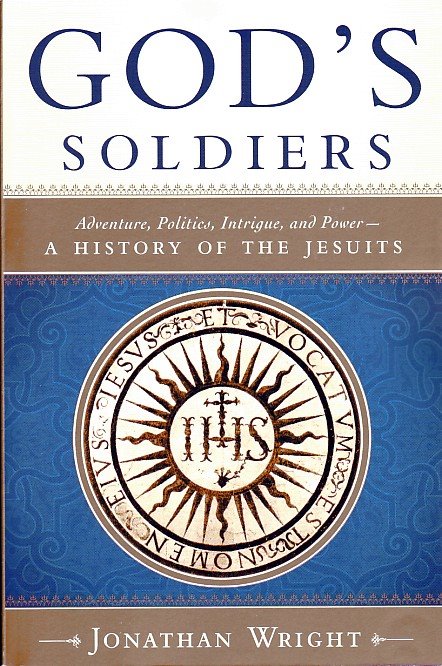One of a couple of books I picked up at the bookshop in
El Retiro San Iñigo:

The back cover reads:
Spanning five continents and nearly five hundred years, this definitive, unvarnished history of the Jesuits captures their tremendous influence on both the religious and secular worlds, as well as the enmity and outrage their power frequently inspired.
Throughout history, members of the Society of Jesus, popularly known as the Jesuits, have been accused of killing kings and presidents, traveled as missionaries to every corner of the globe, founded haciendas in Mexico, explored the Mississippi and Amazon rivers, and served Chinese emperors as map makers, painters, and astronomers. Jesuits have been despised and idolized on a scale unknown to members of any other religious order; they have died the most horrible deaths and done the most outlandish deeds.
Whether they were loved or loathed, the Jesuits' dramatic and wide-ranging impact could never be ignored. By the mid-eighteenth century, they had established more than 650 educational institutions. They were also strongly committed to foreign missions, and they traveled to the Far East, India, and the Americas to stake a claim.
The Jesuits' successes both in Europe and abroad, coupled with rumors of scandal and corruption within the order, soon drew criticism from within the Church and without. Their power was seen as so threatening that hostility escalated into serious political feuds, and at various times they were either banned or harshly suppressed throughout Europe.
God's Soldiers is a fascinating chronicle of this celebrated, mysterious, and often despised religious order. Jonathan Wright illuminates as never before their enduring contributions as well as the controversies that have surrounded them. The result is an in-depth, unbiased, and utterly compelling history.
Again, this entry is no attempt at an exhaustive book review (or even pretends to be one). A handful of comments and a few quotes are all that can be offered. For a brief review, check out
Austin Cline's sentiments on this book.
In 1521, serving military duty under Antonio Manrique de Lara, viceroy of Navarre, while facing French troops at the battle for Pamplona, a cannonball shattered Iñigo López de Loyola's right leg, badly injured the other, and the rest--as they say--is history. During his recovery, all he had to read was Ludolph of Saxony's
Life of Christ and Jacopo de Voragine's
Golden Legend with its saints. Loyola became inspired by the lives of the saints and a desire to emulate them grew in his heart. The next few years saw the former Basque warrior-nobleman undergo a startling transformation:
A night spent before the Black Madonna at the Benedictine monastery in Montserrat prompted Loyola to exchange his robe and sword for a pilgrim's staff and the rough cloak and sandals of a beggar. A spell at Manresa saw him begging, praying, fasting, and flagellating, allowing his hair and fingernails to grow to uncommon length, being treated to visions, and working on his
Spiritual Exercises. The
Exercises, on which Loyola continued to work over the coming decades, would emerge as the lodestone of a distinctive Ignatian spirituality--arguably one of the most impressive, enduring Jesuit contributions to the Roman Catholic tradition. (18)
Founded in 1534 by the Spanish nobleman Ignatius of Loyola, the Society of Jesus began with a dozen theology students at the University of Paris who made a vow to travel to the Holy Land to preach the Gospel to the Saracens--or, failing that, to offer their services to the pope for whatever missions he saw fit to propose. The latter turned out to be their destiny, and from the first the Jesuits were closely associated with papal power and Roman intrigue. Although Ignatius had not originally intended the combat of heresy to be one of his primary tasks, the intellectual and political climate of the times soon demanded it, and his followers proved to be formidable adversaries, winning back entire regions and even kingdoms (e.g. Hungary) to the Church. (
Kirkus Reviews)
Whether loved or loathed, the
Society of Jesus could never be ignored. It would disrupt the certainties and hierarchies of the Catholic Church, transform the intellectual, cultural, and devotional landscapes of Europe, and meddle in successive controversies of reformation, empire building, enlightenment, and revolution. The contest to adjudicate its history was always going to be hard fought.
[ . . . ]
For close on five centuries, Jesuits have maintained a turbulent, influential presence in world history--and not simply as evangelists, theologians, or priestly intermediaries. They have been urbane courtiers in Paris, Peking, and Prague, telling kings when to marry, when and how to go to war, serving as astronomers to Chinese emperors or as chaplains to Japanese armies invading Korea. As might be expected, they have dispensed sacraments and homilies and they have provided educations to men as various as Voltaire, Castro, Hitchcock, and Joyce. But they have also been sheep farmers in Quito, hacienda owners in Mexico, wine growers in Australia, and plantation owners in antebellum United States. The Society would flourish in the worlds of letters, the arts, music, and science, theorizing about dance, disease, and the laws of electricity and optics. Jesuits would grapple with the challenges of Copernicus, Descartes, and Newton, and thirty-five craters on the surface of the moon would be named for Jesuit scientists.
Jesuit missionaries would provide Europe with accounts of unknown cultures, with reports of new rivers, new stars, new animals, plants, and drugs--from camellias to ginseng to quinine--and a dazzling array of exciting commodities in between. Jesuit missionaries would locate the source of the Blue Nile, find land routes from Muscovy to China, and chart large stretches of the Oronoco, Amazon, and Mississippi Rivers. They would bring snuff, and the works of Aesop and Galileo, to Peking, coffee to Venezuela, and Kepler's laws of planetary motion to Indian astronomy.
Such success (alongside no few transgressions) has often bred resentment [ . . ..] Jesuits have never lacked enemies willing to depict them as king-killers, poisoners, or practitioners of the black arts. By Catholics and non-Catholics alike, they have been painted as purveyors of absurdly laxist moral advice, as sexual deviants, as avaricious scoundrels setting up secret gold mines and duping rich widows out of their inheritances. Self-styled champions of intellectual freedom have routinely characterized Jesuits as mindless automatons, unthinkingly loyal to their superiors. For those opposed to Roman influence they have been the pope's myrmidons, the sworn enemies of secular authority. While few have doubted the skill and verve of the Society of Jesus--its prowess in self-publicity, its ability to generate unique theologies and spiritualities, to train up, organize, and motivate its vast and versatile workforce--some have wondered whether such virtuosity was a blessing or a blight.
Reformation Protestants, eighteenth-century philosophers, and nineteenth-century liberals have turned against them. They have infuriated John Donne, Blaise Pascal, Thomas Jefferson, and Napoleon, and if they have sought to guard, define, and cherish their reputation--not least by doting on their saints and martyrs--others have tried to wrest it from their control. (8-10)
The 1540 "Formula of the Institute," a manifesto that formed the basis of the Society's foundation bull, talked of the "propagation of the faith" as a key Jesuit obligation. By 1550 this phrase had become the "
defence and propagation of the faith." There was a world of meaning in this new word "defense." Confronting the type of threat to the church symbolized by the sack of Rome and embodied in the Affair of the Placards very quickly became the Society's business. It would also serve as one of the chief sources of Jesuit pride and self-identity. (26)
Jesuits would form the spearhead of the Roman Catholic Church's
Counter-Reformation against the Protestants:
The Jesuit Edmund Campion, who would be executed in 1581 after a clandestine mission to England, [...] mock[ed] those Protestant "men in the world which drink blood as easily as beasts do water . . . and because the earth does not open up and presently swallow them down . . . think all is well." Both the Protestant and Campion were exaggerating, but both were right in ascribing vileness to their opponents; both were wrong in pretending that those opponents had a monopoly on such unsavory, if theologically sanctioned, kinds of behavior.
Al though some people managed to live through the sixteenth and seventeenth centuries without having to face difficult religious decisions, many were not so lucky. They were expected to hate and avoid their confessional adversaries, and made to endure tormenting crises of conscience: crises involving a choice between the tenets of theological correctness and the other, not ignoble, duties to family, friends, and community, not to mention their own health, wealth, and happiness.
But the real world of the Reformation was also about those people who refused to live by the theologians' rules and who carved out compromises and solutions of their own. Reformation was about people who resented the tone of it all, who were annoyed that "religion is strangely metamorphosed into snarling," and that "a generation of tautological tongue men" had "brought too much gall to the pulpit and such a store of wormwood to the press, that hath drowned too many of us in the gall of bitterness." Above all the Reformation was about confusion: the fact that not everyone could quite see the obviousness of the choices put before him.
And if people were being prevented from living quiet lives in noisy times, if they were being urged to snap out of their confusion, who was responsible? One seventeenth-century onlooker had a suggestion: surely it was those most zealous and uncompromising figures at opposite ends of the religious spectrum, the Calvinists of Geneva and the Jesuits of Rome, each as unflinching as the other, "tail-tied together with firebrands between them."
Protestantism, according to James Brooks, preaching in 1553, was the "filthy sink" from which had emerged "all these tragedies which hath raged well nigh over all Christendom, out of which hath raked of late so many stinking, filthy, contagious heresies." Heresy was a fever to be cooled, excrement to be evacuated, humoral imbalance to be righted. The Jesuits, as the rhetoric often went on to say, were the spiritual physicians, dispensing the antidotes, the counterpoison, the purgative, the cauterizing agent, disabusing and disheartening Protestants and healing wayward Catholics. And as contemporary medical theory insisted, the best doctors always appreciated the full range of remedies and procedures--some gentle, others violent--at their disposal. (27-9)
In seminaries across Europe, the Society of Jesus would train priests (Jesuits and non-Jesuits alike) destined for careers on the front lines of counterreformation; their duty, as laid down in 1552, to "search out the hidden venom of heretical doctrine and to refute it, and then to replant the uprooted trunk of the tree of faith." Many of the first Jesuit missionary initiatives in England, Bohemia, France, Hungary, Germany, and Poland sought to take the battle directly to the Protestant enemy, to win back souls from Lutheranism and Calvinism and shore up the resolve of those Catholics most immediately at risk of falling into schism. (31)
Accounts of the furious exchange between the Jesuits and the Protestants are sometimes presented with more than a tinge of wit:
What the Protestants insulted, Jesuits promoted. Calvinists mocked the Blessed Sacrament--the consecrated bread reserved outside the celebration of the Eucharist; Jesuits displayed it to the faithful in forty-hour rituals, lighting it, during one such spectacle at their mother church, the Gesù, in Rome, with twenty-three hundred lamps and five hundred candles. Protestants grumbled about the Catholic obsession with saints; Jesuits made sure that students at their schools prayed before images of their impeccably holy predecessors whenever they entered their classrooms. [ . . . ]
Jesuits knew how to score a rhetorical point, and they did not always shy away from insulting their Protestant adversaries--routinely blaming them for the onset of plague, for instance. (32)
The Jesuits proved themselves to be formidable adversaries to the Protestant challenge:
It was doing all of these things, of course: adoring saints and sacraments was about articulating long-cherished Catholic spirituality
and it was about rebutting Protestant innovation. Jesuits avidly endorsed both campaigns.
There must surely have been satisfaction in hearing a Protestant grumble in 1641 that "it is well known . . . that the Jesuits (the pope's best and dearest sons) have not yet troubled the world a hundred and twenty years . . . [but] what service they have done their master the pope, all men guess, wise men know, and all nations in Christendom feel to their pain, more or less." As William Crashaw continued just two years later, Luther and Calvin had made the "Romish Church . . . that scarlet whore" feel old, exhausted, and impotent: she had realized that "in this latter age her cup of abominations was almost drunk up and emptied even to the dregs." But then, in the autumn of 1540, the Jesuits had made their entrance, flying like locusts "out of the bottomless pit, to repair the ruins of the Romish state and to fill her golden cup up with a new supply of spiritual fornications." If Protestants were quite that cross, the Society must have been doing something right. (35)
In fact, so effective were the Jesuits against the Protestants that Pope Gregory XIII remarked to a member of the Society in 1581 that "there is in this day no single instrument raised by God against heretics greater than your holy order. It came into the world at the very moment when new errors began to spread abroad" (21-2). Speaking from personal experience, even today, fundamentalist and evangelical Protestants wishing to "convert" me, change their minds when they discover I am a
Jesuit university alumni and attend mass there.
Being at the spearhead of the battle against the Protestants meant that more than a few of the Jesuits would end up martyred for the cause:
By most standards, the later career of Thomas Cottam, graduate of the English College at Douai and the Jesuits' Sant' Andrea novitiate in Rome, was something of a debacle. When he arrived at Dover in 1580 [...], the port officials were expecting him. A spy had made his acquaintance in Lyons and dutifully informed the English ambassador in Paris, who, in turn, had let his employers know that another Jesuit was planning a mission to bolster the morale of England's benighted Catholic community. Cottam actually succeeded in shaking off his pursuers but only by placing a fellow Catholic in jeopardy, and so, in service to conscience, he gave himself up. After spells of incarceration in the Tower and Marshalsea Prison, where he was treated to the delights of the rack and the "
scavenger's daughter," Cottam was convicted of high treason on November 20, 1581.
Having watched three diocesan priests perish before his eyes--their innards ripped out and their limbs chopped off--Cottam was hanged on May 30, 1582. Astutely, those presiding over his execution threw his mutilated body into vats of boiling water, thus preventing any sympathetic bystanders from collecting the martyr's relics.
Elizabethan England was a perilous place for any member of the Society of Jesus. Suspected (and not always undeservedly) as political agitators, the "rabble of vagrant friars," reduced to traveling around England in disguise and under false names, would bear the brunt of anti-Catholic legislation. A dozen other Jesuit missionaries would perish before 1603, and though numerically modest, and for all the rows and rifts it provoked within the Catholic community, the Jesuit presence in England was always capable of scandalizing Protestant magistrates and edifying wavering Catholics. (29-30)
Trivia: exactly 426 years ago, on the 3rd of July, 1580, Queen Elizabeth I issued a statute forbidding Jesuits all entrance into England.
The requirements for membership into the
Society of Jesus are biased toward the intellectual, and sometimes bear more than a passing whiff of elitism:
The Society had long had its ways, unusually lengthy and rigorous, of training its membership [ . . ..]
The Society's founding documents were replete with advice about who might best enjoy the privilege of becoming a Jesuit. Naturally, anyone who was married, or subscribed to erroneous religious opinion, or suffered from mental instability was ruled out, and unless absolute reformation of character had taken place, a person guilty of homicide or otherwise "publicly infamous because of enormous sin" was unlikely to have a Jesuit future ahead of him. It was important that a candidate be asked whether "he has any stomach trouble or headaches or trouble from some other bodily malfunction" since a Jesuit's life could well turn out to be physically demanding; and as well as concerns about "a lack of bodily integrity, illness and weakness," there were no doubts about individuals possessed of "notable ugliness." "Persons who have notable disfigurements or defects, such as hunchbacks and other deformities, whether they be natural or accidental as from wounds and the like," were at a disadvantage because such "obstacles to the priesthood . . . do not help towards the edification of neighbors."
However, such physical encumbrances could be confidently ignored if a candidate with exceptional talents presented himself. The guiding principle to be observed by those in charge of Jesuit admissions was that "the greater the natural and infused gifts someone has from God our Lord which are useful for what the society aims at . . . and the more experience the candidate has in the use of these gifts, the more suitable will he be for reception into the Society." Wealth and social status, it was averred (though this was not always heeded), simply did not matter; qualities such as spiritual vigor, an affection for the Society, a good memory, and a pleasing manner of speech most certainly did.
In the Jesuit scheme of formation as it eventually emerged, a two-year novitiate--of probation and spiritual instruction--was followed by the moment at which three simple, perpetual vows of chastity, poverty, and obedience were taken. At this time a decision was made as to whether an individual was destined to become a brother or a scholastic (intended for the priesthood--although express dispensation would always be required if, at a later date, a Jesuit aspired to any ecclesiastical dignity such as a cardinal's hat). For the scholastic, years of study in philosophy (three years as a rule) and theology (usually four years) lay ahead, interrupted by the "regency," usually taken up with teaching duties. Finally, the period of "tertianship" would arrive, during which an individual revisited more spiritual concerns, and spent time making the
Spiritual Exercises in full. At this point, the three vows of poverty, chastity, and obedience were repeated, and it was decided whether the now fully formed Jesuit was to become a spiritual coadjutor or a "professed" Jesuit, who had the honor of taking the additional, fourth vow, of obedience to the pope as regards missions. It was from the elite, relatively small body of the professed that superiors were chosen.
Those who were chosen to be brothers, or temporal coadjutors, accounted for something like a quarter of the membership. This group--which, the constitutions meanly suggested, ought to be content with the equivalent of the Bible's Martha in the Society--worked as gardeners, builders, and cooks, but also included within their number eminent architects such as Peter Huyssens and Andrea Pozzo, an explorer like Bento de Goes (the first Jesuit to find a land route between India and China, via Lahore and Kabul), and the much-doted-upon Alphonsus Rodriguez, a lowly porter at the Society's college at Palma, Majorca, whose exemplary and deeply spiritual life would be held up for admiration by generations of Jesuits, even securing him canonization in 1888. (47-9)
But perhaps the most visible facet of Jesuits today is the role they play in education.
By the mid-seventeenth century they had a virtual monopoly in the role of confessor to the likes of the kings of France and the dukes of Bavaria, and although it was not part of their original brief, they were now a dominant force in the education of the Catholic world. This development, which inevitably meant setting up permanent educational establishments, rather diluted the concept of itinerant ministry so dear to Loyola and his earliest collaborators. But it also made the Society truly revolutionary: it became the first religious order of the Catholic Church to adopt formal education as a significant ministry.
The Society trained not only its own recruits but a sizable portion of the secular clergy of Europe. Colleges dedicated to training, among others, German, Hungarian, Greek, and English priests were placed in Jesuit hands, and it would soon become clear that locating an archbishop of Vienna not educated by the Society would be a fool's errand. In 1621, the first Jesuit-trained pope, Gregory XV, took possession of the papal tiara.
And there were the children (Catholic and even, on occasion, Protestant) who were taught in a worldwide network of schools and colleges, expanding from humble beginnings in Spain, at Gandía in 1546 and in Sicily at Messina in 1547 (the first institution primarily intended for non-Jesuit pupils, or "externs"), at an average of six new institutions a year by the end of the sixteenth century. Leaders of the Society had grown accustomed to turning down many of the requests to establish schools that came flooding in, and by 1600 there were fifty-six institutions in Italy and Sicily alone, seventy-seven in Spain and its overseas empire. In France, where Jesuits were teaching as many as forty thousands by 1630, figures as eminent as Descartes, Corneille, Bossuet, and Molìere would receive a Jesuit education, and although some of these men would be far from kind to their former teachers, those taught in Jesuit schools would also manage to provide the Society with more than half its novices.
[ . . . ]
Jesuit schools, although we should be wary of generalizations, sought to combine the educational advances of humanism--which included a reverence for classic culture--with the duty to produce pious members of Christian society. Students were obliged to examine their consciences, develop an interior spirituality, and attend mass every bit as they were expected to read Cicero or hone their skills in Latin metrics and prosody. In this decidedly Christian-humanist way, the Society set about training students to be good Christians and virtuous citizens, but it also strove to produce eloquent, elegant members of the secular world.
Jesuits wrote about the art of courtly wisdom; they sometimes employed dance masters in their schools to cultivate refined gesture and posture; and the popularity of dramatic productions and staged disputations amply testified to the importance afforded to rhetorical proficiency. There was a rejection of Machiavellian pessimism--Machiavelli was the sort of person to be burned in effigy, which is just what Jesuits did at Ingolstadt in 1555--and a confidence that a person could be eminently devout at the same time as being a successful politician or lawyer. (53-4)
I am not sure if Jonathan Wright covers it, but it would be interesting to read how the Jesuits superseded the older Franciscans and Dominican orders in the mission of education.
The next installment on this fascinating book would focus on the role Jesuit missionaries played in empire building and colonialism.

Trivia: 2006 is a Jubilee year observing, the 500th anniversary of the birth of Saint Francis Xavier, born April 7, 1506; the 500th anniversary of the birth of Blessed Peter Faber, born April 13, 1506; and the 450th anniversary of the death of Saint Ignatius Loyola, July 31, 1556.



































